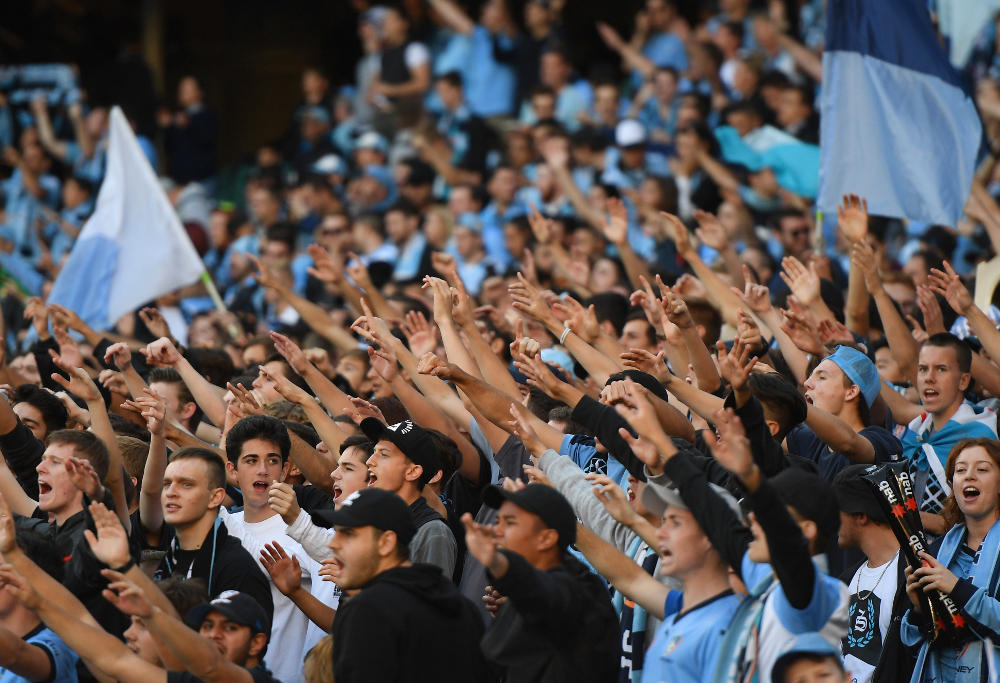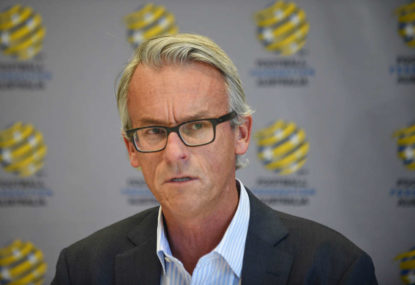“This confirms that football is entitled to be ambitious and confident in its future.” said David Gallop after last season’s grand final.
The record viewership garnered that night, watching what ended up being a tense, cagey skirmish between the two best teams in the league, was rightly wheeled out and showed off by the sport’s governing body.
“On top of a sold-out match, the broadcast numbers for the Hyundai A-League 2017 grand final were truly outstanding,” said Gallop, “with the grand final broadcast to 115 territories globally, this could very well be the most watched A-League match in history.”
Indeed, last season was a sparkling rollick, fuelled largely by Sydney FC’s year-long dominance, and was punctuated with some firebrand derbies in the nation’s two biggest cities.
The subsequent months have seen the Matildas achieve new, raucous levels of success and exposure, as well as a Socceroos World Cup campaign that has attracted more interest and discussion than ever, albeit often for reasons – and results – many fans would rather not have to talk about.
Football is now making a deeper, longer-lasting national impression; the national teams are even maintaining the momentum over the off-season.
So why, as the domestic league kicks off again, has the promotion for the 2017-18 season been so muted? Last season’s ‘You’ve gotta have a team’ campaign was, by most accounts, a success, in spite of Yoshi’s egregious plasticity as a fan.
The point of that campaign, one assumes, was to plant the seeds of devotion; casual observers were urged to evolve into impassioned participants, picking a team, painting their faces in the appropriate colours.

(AAP Image/Dean Lewins)
So much fervour over the course of the season revolves around the city derbies, which of course are events that trade entirely on the currency of partisan rivalry, even the Melbourne Derby which is rather lopsided when it comes to the two teams’ active support.
Football is at its healthiest when fans are devoted to their teams, and are vocal about it on matchday, and more fans, the better.
So if that was the point of the last campaign, it seems a little strange to re-up another edition this season, one that seems a little watered down on its second time around.
Gallop spoke on this season’s recycled campaign last week: “We will follow up the success of last year’s ‘You’ve gotta have a team’ campaign with fanbassadors at each club,” he said. “It’s part of the ongoing strategy to connect the base of the pyramid to the A-League and W-League.”
The A-League website has a blazing “You’ve gotta have a team” banner at the top of the home page, urging visitors to “Find your team here”. Clicking on the banner takes you to a rather pared-back page, where there are embedded images of A-League players, W-League players and kids acting as “fanbassadors”.
Click on any of them, and a brief biography comes up, complete with eye-drooping sentences based around elementary scoring or international appearances stats, as well as hackneyed cliches, like how Johan Absalonson “will add another dimension to the Reds’ forward line”, and “will deliver inch-perfect crosses into the area”.
As much as it must have been a thrill for 12-year-old Josh from Peregian Beach to be chosen as fanbassador for the Roar, finding out he “is passionate about developing his skills in football” and “loves to take on new challenges” isn’t really getting the heart racing in preparation for what might be the biggest A-League season ever.
What about the free-to-air television deal secured with Network Ten? How much has that been hyped up pre-season? Well, the network – recently acquired by CBS and set to broadcast Saturday night A-League fixtures for the next two years – hasn’t done much to promote its coverage of the league; it’s difficult to find a marketing promo anywhere online, and the Ten Sport website only has two articles posted in their A-League section, one announcing the broadcast deal, the other announcing the season fixtures.
Seeing as the huge portion of young people don’t own or watch free-to-air television – and are the key demographic both the league and Ten want to appeal to – perhaps there’s a presence on their catch-up portal, reminding all the on-demand-ites of the impending season.
No, even the advertisements embedded in catch-up episodes of their recent sporting programs have no trace of the A-League. Considering the fact Ten are shirking their share of marketing responsibilities, the FFA should really be doing everything they can to make up for this.
Perhaps they have invested in a hefty online presence? Well, the A-League YouTube channel hasn’t uploaded a video for two years, and while the FFA’s YouTube account seem to have dedicated time to promote the Matildas match against Brazil on their channel, as well as putting out a number of sponsored Father’s Day-themed videos with various Socceroos, there is nothing over the last month that mentions the domestic comp.
The club channels post various content promoting a kit launch, or a new signing, obviously more concerned with rousing their specific supportership than the league’s generally.
The A-League Instagram account posts photos regularly, though nothing too innovative or eye-catching, and the A-League Twitter account appears primarily to re-tweet from the various clubs or players.
Fox Sports are making up some ground online – their online coverage of the FFA Cup is excellent, for example – but clearly have their own profit margins chiefly in mind, not necessarily the betterment of the league more generally.
Now, clearly it’s difficult for the A-League and FFA to compete at this time of year; the sporting stage is dominated in late September by the AFL and NRL grand finals.
The A-League can’t yet hope to drown out that noise, and it might be viewed as a waste of funds to try. But if the extent of this season’s efforts are the clever combination of the words ‘fan’ and ‘ambassador’, and a few copied-and-pasted bios, then we’re entitled to demand more.
The FFA’s 2015 “Whole of Football Plan” has a whole section dedicated to outlining how the FFA will connect with the fans. It begins by asserting that its research indicates fandom is based on tribalism and loyalty, but then confusingly props up the idea that “Supporting one team will not stop you supporting another”, setting it as one of its targets.
That baffling contradiction aside, it also emphasises the importance of digital channels when it comes to reaching out to fans, especially teenagers. It’s hard to see evidence of this, two years, later, with the FFA’s various digital accounts stale or dead.

How should the marketing be structured? The old method, building ads around the name-brand marquees are less viable now because while the marquees have improved on the dawdling standards set by Emile Heskey and a washed-up Harry Kewell, names like Adrian Mierzejewski and Oriol Riera don’t rate as well in the focus groups.
What should the new approach be centred around? Perhaps our champion teams, and their place in Asia? The AFC Champions League’s awkward scheduling makes that difficult. And where should the FFA focus their efforts, on television, radio, or new media? Perhaps a spot of skywriting?
What’s clear is that, either bolstered by or in spite of the FFA’s marketing plan, the A-League – and football generally – has prospered over the last five years. Everyone reading this article is likely just as excited for the 2017-18 season to begin as they would be were it accompanied by some flashy advert, or a novel online campaign.
But for the rest of the untapped masses, especially the ones who already play football but don’t follow the A-League, the FFA’s current efforts are falling short.































































































